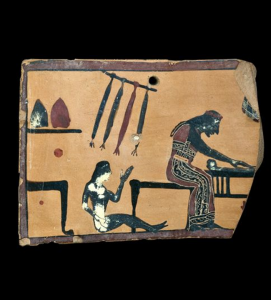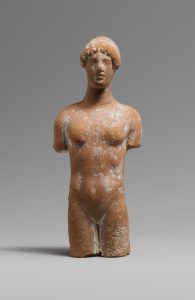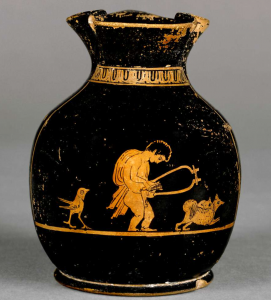Looking for Family
Danielle Szymezko-Singer
For Classical Athenians, the family could mean a variety of things. According to author Janet Morgan, the typical Athenian family was very similar to what we in North America call a “nuclear family”. A “nuclear family” is considered a family with parents and children. Whereas the most common type of family in Athens consisted of the husband, wife, and children, it also included the possibility of enslaved workers, whose numbers depended on the wealth and status of the household. Although the most common type of family, this was not the only type of family household that we come across in that era. Trials in the Athenian courts reveal that a variety of family arrangements were possible. In Lysias 3.6, for example, the speaker lives with his sister and his nieces. They are still a family but do not fit this “nuclear family” model that we have in our minds. An example of another type of family is in Demosthenes 57.40 where we are introduced to the idea of stepparents, remarriage, and half-siblings. Families even included adopted members, but whereas adopting newborns is common in North America today, the adoptees were young adults (often a nephew) who could keep the oikos reproducing and its wealth intact.
As diverse as the families could be in classical Athens, they each had a very similar family dynamic. Different members within the household were responsible for different duties and jobs both within and outside of the oikos. These duties were typically distributed based on gender and status. In Xenophon’s Oeconomicus 9.2-10, we see the husband and wife in a discussion of how their household would be run, both inside and out, with the assistance of enslaved workers. First, we have the husband or the eldest male within the household. This individual was considered the “manager” of the household and he would not typically partake in performing household duties himself, unless from a lower-class family. He would, instead, dictate to his wife, and enslaved workers what tasks within the household they were responsible for. He would also train his wife to fill his role as supervisor of enslaved workers within the house. In doing so, he expected his wife to act towards these workers the same way he would and to reward and punish them as appropriate. Next, the text details the wife’s role within the household. The wife typically performed household duties such as cooking, cleaning, and weaving, often working alongside the enslaved workers. As previously mentioned, she was also responsible for managing the enslaved people working inside the household while her husband was absent. In this text, she has important responsibilities, but is like an assistant to her husband and is expected to defer to him on any issue. In less wealthy families, such strict gender roles were not likely possible in the running of the household, but a wife’s obedience to her husband would still be expected.

Next, we have the children. Children are not often talked about in written sources, and it is difficult to find material evidence of their presence within the household. While young children in North America often live a carefree life with a variety of toys, Athenian children did not. Athenian children often spent the majority of their time accompanying their parents, learning the duties that they would have to perform as adults, both at home and when they were married and had started their own families. Pictured here is a painted plaque which is depicting a scene of a young girl accompanying presumably her mother and watching her do some weaving. According to Plato (Laws 1.643c) children were encouraged to develop skills for their future working lives by playing with miniature versions of these tools.
In contrast to modern-day North America, children were not immediately considered a member of the family once they were born, regardless of their parents’ status. When a child was born, the head of the household was responsible for inspecting the child and validating the child as a member of the oikos. After this took place, on the fifth or seventh day after birth, the Amphidromia was held. The Amphidromia was a religious event where the family would make a sacrifice to the gods and the father would walk around holding the child up in the air to indicate his acceptance of the child into the household. Afterward, they would have a small feast where only the family or anyone who was present for the birth attended. On the tenth day after the birth, depending on the wealth of the family, they might also hold a dekate, which was more of a festive event where they held a feast, with entertainment for family and friends, in the celebration of the birth.
Children were also seen as a representation of their family’s thoughts, ideals, or beliefs. Athenians would often have their child’s personal name be representative of something important to the family. Mark Golden discusses how a common name for young boys was Hegesistratus or Hegesias for short. This was indicative of a militaristic family as it meant “army leader”. He goes on to explain how these speaking names allowed parents an opportunity to express opinions on political matters, as well as mold their children’s sense of self. This would also indicate the values of the family and the broader community that they lived in.
Is it a Doll?

As previously mentioned, children often played with tools that would help them to develop skills that they would need to perform tasks later on in life. It has proven difficult, however, to establish what was considered to be a children’s toy from what was considered an item used in offerings, either for the gods or for ritual practices. This fact has also makes finding evidence of children within the household through the archaeological record difficult. For instance, Joan Reilly makes mention of terracotta dolls that were discovered in excavations and sometimes depicted on tombstones, but they were not your typical “Barbie” type of doll. Instead, as pictured to the left, these dolls were anatomical votives. It was believed that these votives assured that the young girl would hold a healthy female body that was capable of reproduction. Therefore, what we may consider to be toys, was not a toy to Athenian children. This observation makes it extremely difficult to find evidence of children archaeologically but also shows how their lives went beyond the carefree lifestyle which children in North America have today.

Pets, including dogs, cats, and birds, were also important members of the oikos. In Classical Athenian art, we see two types of dogs depicted. One breed is considered “hounds”. These dogs would often accompany the men on hunting activities where they would help attack and take down the animals. The other breed was Maltese dogs. The Maltese were what we might consider lap dogs and household family pets. They were normally depicted accompanying and playing with young children and women, as seen on this red-figured chous. Archaeological evidence also reveals that families sometimes honoured dogs with burials, suggesting a close bond between families and their pets as well as grief at their loss. Pets appear to have been as important a family member to Classical Athenians as they are to us in North America today.
The concept of family, what defines a family, and who was considered a family member was very diverse in Classical Athens. Although a family was more commonly classified as our modern-day “nuclear family”, there exist many examples in the sources showing that a family was also much more than that. Overall, though, the family dynamic and roles within the household were affected by gender and status, and this will be covered further in other chapters throughout the book.
Bibliography and Further Reading
- Golden, M. 2015. Children and Childhood in Classical Athens. 2nd edition. Baltimore: Johns Hopkins University Press.
- Morgan, J. 2010. The Classical Greek Household. Exeter: Bristol Phoenix Press.
- Reilly, J. 1997. “Naked and Limbless: Learning About the Feminine Body in Ancient Athens”. In Naked Truths: Women, Sexuality and Gender in Classical Art and Archaeology, edited by A.O. Koloski-Ostrow and C.L. Lyons, 154-173. London: Routledge.
- Whiting, C. 2022. “Video #19: Dogs in Ancient Athens with Colin Whiting.” Peopling the Past. https://peoplingthepast.com/2022/02/02/video-19-colin-whiting/.

